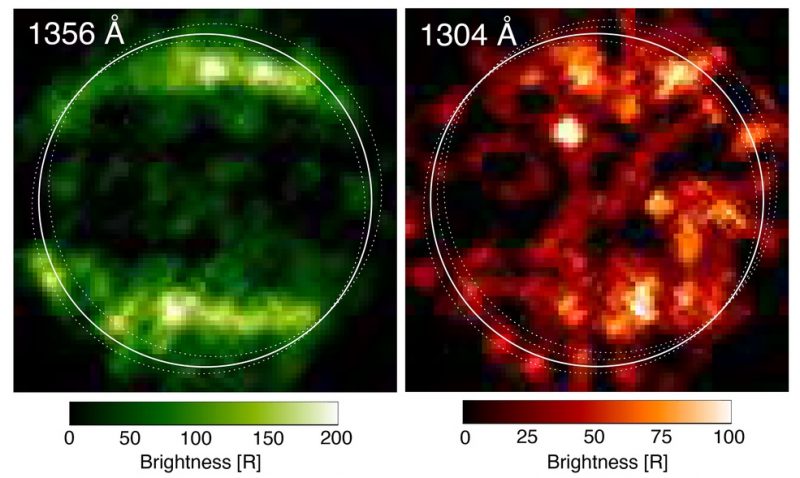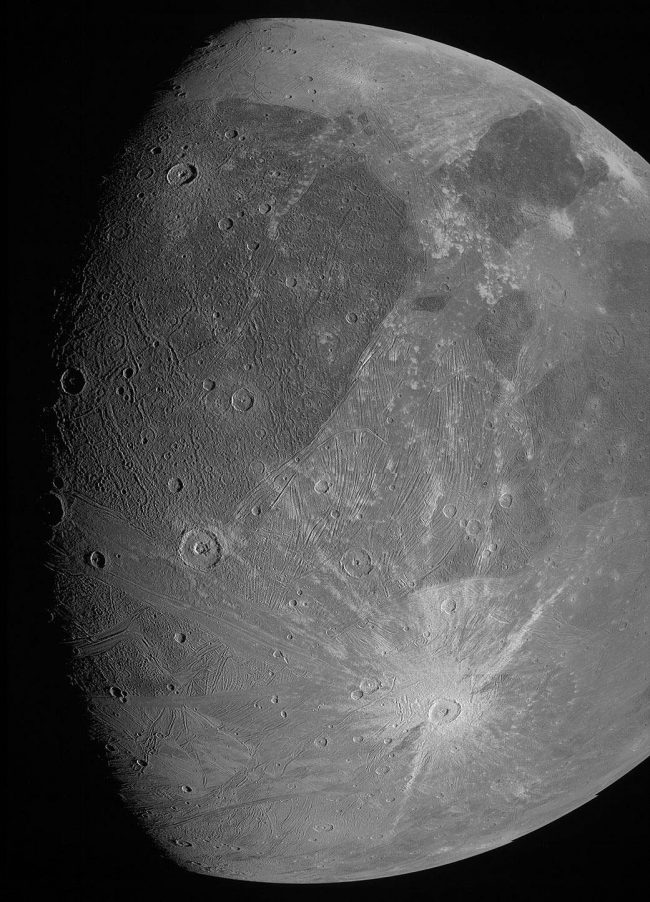Water vapor on Ganymede
Scientists have found the first evidence of water vapor on Ganymede, a world orbiting Jupiter and the largest and most massive moon in our solar system. They said this discovery is a step toward understanding the habitability of moons orbiting giant planets. At noon around Ganymede’s equator, temperatures apparently get warm enough for parts of the moon’s icy crust to sublimate. That is, the ice goes directly from a solid to a gas, releasing water vapor.
The researchers made the discovery with the help of archival data from the Hubble Space Telescope, together with some new data. They published their findings on July 26, 2021, in the peer-reviewed journal Nature Astronomy.
In 1998 and 2010, the Hubble Space Telescope observed Ganymede in ultraviolet (UV) light. Images from both observations revealed an aurora zone for Ganymede, a sign that this large moon has a permanent magnetic field, produced by an iron core. Ganymede also orbits within Jupiter’s magnetic field. But the regions of active aurorae on Ganymede looked different in 2010 than they did in 1998. And scientists thought these differences might be due to the presence of atomic oxygen in Ganymede’s thin atmosphere.
Fast forward almost a decade, to 2018. A team of astronomers led by Lorenz Roth of the Royal Institute of Technology in Stockholm, Sweden, reexamined the Hubble UV data. They used the old data alongside new data from Hubble’s instrument Cosmic Origins Spectrograph. The new data measured the amount of atomic oxygen in Ganymede’s atmosphere. What they found was that the moon Ganymede has hardly any atomic oxygen. This finding upended their explanation for the differences in the UV auroras.
Then Roth’s team looked more closely at where the UV auroral displays were on Ganymede. That’s when they made an interesting discovery. The locations of Ganymede’s aurorae correlated with where they’d expect to find water Ganymede’s atmosphere, if the moon was releasing water vapor. Roth explained:
So far only the molecular oxygen had been observed. This is produced when charged particles erode the ice surface. The water vapor that we measured now originates from ice sublimation caused by the thermal escape of water vapor from warm icy regions.

Missions to the ice world Ganymede
Ganymede has a thick crust made of ice. An ocean may lie below that crust, more than 100 miles (160 km) deep. Scientists think Ganymede might be hiding more water under its crust than that found in all of Earth’s oceans.
Ganymede’s icy nature makes it the target of an upcoming European Space Agency (ESA) mission named JUICE, for JUpiter ICy moons Explorer. ESA plans to launch JUICE in 2022 for it to arrive at the giant planet in 2029. It will target not only Ganymede but also Europa and Callisto. Meanwhile, Jupiter’s 4th Galilean moon, Io, is a hot, volcanic world.
The new discovery of water vapor can help refine future mission objectives, these scientists said. Roth explained:
Our results can provide the JUICE instrument teams with valuable information that may be used to refine their observation plans to optimize the use of the spacecraft.
Another mission, Juno, is currently orbiting Jupiter and sending back fresh images of Ganymede, which you can see here.
Water is key to life as we know it. It’s key the habitability of planets and moons (insofar as we understand what “habitability” means). Scientists said that the discovery of water vapor on Ganymede will help us understand where, beyond Earth, life might exist in our home galaxy, the Milky Way.

Bottom line: For the first time, scientists have found evidence of water vapor on Ganymede, Jupiter’s largest moon.
Source: A sublimated water atmosphere on Ganymede detected from Hubble Space Telescope observations











